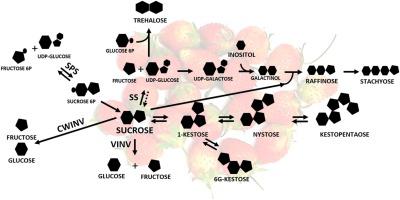当前位置:
X-MOL 学术
›
Postharvest Biol. Technol.
›
论文详情
Our official English website, www.x-mol.net, welcomes your feedback! (Note: you will need to create a separate account there.)
Involvement of oligosaccharides and sucrose-related genes on sucrose retention in strawberries from ripening to shelf-life
Postharvest Biology and Technology ( IF 7 ) Pub Date : 2020-11-01 , DOI: 10.1016/j.postharvbio.2020.111301 Ivan del Olmo , Maria Blanch , Irene Romero , Maria Vazquez-Hernandez , Maria Teresa Sanchez-Ballesta , Maria I. Escribano , Carmen Merodio
Postharvest Biology and Technology ( IF 7 ) Pub Date : 2020-11-01 , DOI: 10.1016/j.postharvbio.2020.111301 Ivan del Olmo , Maria Blanch , Irene Romero , Maria Vazquez-Hernandez , Maria Teresa Sanchez-Ballesta , Maria I. Escribano , Carmen Merodio

|
Abstract Sucrose is a key player in strawberry metabolism. However, the molecular mechanisms underlying sucrose status in strawberries during later ripening stages and postharvest storage remains quite limited. Therefore, we identified members of various gene families encoding key enzymes involved in sucrose metabolism, analyzed their expression profiles and determined the sugar content in strawberries at different ripening stages and postharvest treatments. Three different ripening stages around harvest time, almost red (AR), full red (FR) and dark red (DR) were analyzed, as well as after pre-treatment with high CO2 levels (18 % CO2, 2 d) during low temperature (LT) storage and further shelf-life at 20 °C. The accumulation of sucrose, hexoses, trehalose, myo-inositol, fructo-oligosaccharides (FOS) and raffinose family oligosaccharides (RFOs) was analyzed. Our results indicate that the transition from FR to DR stages was characterized by a prominent accumulation of hexoses, sucrose and a sharp decrease in the levels of FOS. We therefore suggest that FOS, in addition to their protective role in stressful conditions, are also important metabolic signals of the end of ripening process. The highest levels of RFOs was detected in strawberries at LT in air, making them a possible marker of damage, an idea reinforced too by the low RFOs and high myo-inositol quantities found in high CO2 protective treatment. Interestingly, the sucrose accumulation in fully ripe strawberries and in high CO2-treated ones was linked to a significant decrease in the expression of FvVIN2 (vacuolar invertase), an opposite trend to that observed in fruit stored in air. Furthermore, high levels of CO2 prevented both the upregulation of FvSS1 and the sharp increase in the expression of FvCWINV1 observed at low temperature in air. The efficiency of high CO2 pre-treatment on sucrose accumulation was particularly evident during the shelf-life period at 20 °C (SL) after LT storage. Our study provides new insights into how strawberries become sweet by retaining sucrose content. Additionally, our results clearly highlight the need to specify the sugar status at harvest to know the effectiveness of a treatment in maintaining quality attributes.
中文翻译:

低聚糖和蔗糖相关基因对草莓从成熟到货架期蔗糖保留的影响
摘要 蔗糖是草莓代谢的关键参与者。然而,草莓在成熟后期和采后储存期间蔗糖状态的分子机制仍然非常有限。因此,我们鉴定了编码参与蔗糖代谢的关键酶的各种基因家族的成员,分析了它们的表达谱并确定了草莓在不同成熟阶段和采后处理的糖含量。分析了收获时间前后的三个不同成熟阶段,几乎红色 (AR)、全红色 (FR) 和深红色 (DR),以及在低温期间用高 CO2 水平(18 % CO2,2 天)预处理后(LT) 储存和进一步的保质期在 20 °C。蔗糖、己糖、海藻糖、肌醇的积累,分析了低聚果糖 (FOS) 和棉子糖家族低聚糖 (RFO)。我们的结果表明,从 FR 到 DR 阶段的过渡的特征是己糖、蔗糖的显着积累和 FOS 水平的急剧下降。因此,我们认为 FOS 除了在压力条件下的保护作用外,也是成熟过程结束的重要代谢信号。在空气中 LT 的草莓中检测到最高水平的 RFO,使它们成为可能的损伤标志,在高 CO2 保护处理中发现的低 RFO 和高肌醇量也强化了这一想法。有趣的是,完全成熟的草莓和高 CO2 处理的草莓中的蔗糖积累与 FvVIN2(液泡转化酶)的表达显着降低有关,与在空气中储存的水果中观察到的趋势相反。此外,高水平的 CO2 阻止了 FvSS1 的上调和在空气中低温下观察到的 FvCWINV1 表达的急剧增加。在 LT 储存后 20 °C (SL) 的保质期内,高 CO2 预处理对蔗糖积累的效率特别明显。我们的研究为草莓如何通过保留蔗糖含量而变甜提供了新见解。此外,我们的结果清楚地强调了需要在收获时指定糖的状态,以了解处理在保持质量属性方面的有效性。在 LT 储存后 20 °C (SL) 的保质期内,高 CO2 预处理对蔗糖积累的效率特别明显。我们的研究为草莓如何通过保留蔗糖含量而变甜提供了新见解。此外,我们的结果清楚地强调了需要在收获时指定糖的状态,以了解处理在保持质量属性方面的有效性。在 LT 储存后 20 °C (SL) 的保质期内,高 CO2 预处理对蔗糖积累的效率特别明显。我们的研究为草莓如何通过保留蔗糖含量而变甜提供了新见解。此外,我们的结果清楚地强调了需要在收获时指定糖的状态,以了解处理在保持质量属性方面的有效性。
更新日期:2020-11-01
中文翻译:

低聚糖和蔗糖相关基因对草莓从成熟到货架期蔗糖保留的影响
摘要 蔗糖是草莓代谢的关键参与者。然而,草莓在成熟后期和采后储存期间蔗糖状态的分子机制仍然非常有限。因此,我们鉴定了编码参与蔗糖代谢的关键酶的各种基因家族的成员,分析了它们的表达谱并确定了草莓在不同成熟阶段和采后处理的糖含量。分析了收获时间前后的三个不同成熟阶段,几乎红色 (AR)、全红色 (FR) 和深红色 (DR),以及在低温期间用高 CO2 水平(18 % CO2,2 天)预处理后(LT) 储存和进一步的保质期在 20 °C。蔗糖、己糖、海藻糖、肌醇的积累,分析了低聚果糖 (FOS) 和棉子糖家族低聚糖 (RFO)。我们的结果表明,从 FR 到 DR 阶段的过渡的特征是己糖、蔗糖的显着积累和 FOS 水平的急剧下降。因此,我们认为 FOS 除了在压力条件下的保护作用外,也是成熟过程结束的重要代谢信号。在空气中 LT 的草莓中检测到最高水平的 RFO,使它们成为可能的损伤标志,在高 CO2 保护处理中发现的低 RFO 和高肌醇量也强化了这一想法。有趣的是,完全成熟的草莓和高 CO2 处理的草莓中的蔗糖积累与 FvVIN2(液泡转化酶)的表达显着降低有关,与在空气中储存的水果中观察到的趋势相反。此外,高水平的 CO2 阻止了 FvSS1 的上调和在空气中低温下观察到的 FvCWINV1 表达的急剧增加。在 LT 储存后 20 °C (SL) 的保质期内,高 CO2 预处理对蔗糖积累的效率特别明显。我们的研究为草莓如何通过保留蔗糖含量而变甜提供了新见解。此外,我们的结果清楚地强调了需要在收获时指定糖的状态,以了解处理在保持质量属性方面的有效性。在 LT 储存后 20 °C (SL) 的保质期内,高 CO2 预处理对蔗糖积累的效率特别明显。我们的研究为草莓如何通过保留蔗糖含量而变甜提供了新见解。此外,我们的结果清楚地强调了需要在收获时指定糖的状态,以了解处理在保持质量属性方面的有效性。在 LT 储存后 20 °C (SL) 的保质期内,高 CO2 预处理对蔗糖积累的效率特别明显。我们的研究为草莓如何通过保留蔗糖含量而变甜提供了新见解。此外,我们的结果清楚地强调了需要在收获时指定糖的状态,以了解处理在保持质量属性方面的有效性。



























 京公网安备 11010802027423号
京公网安备 11010802027423号